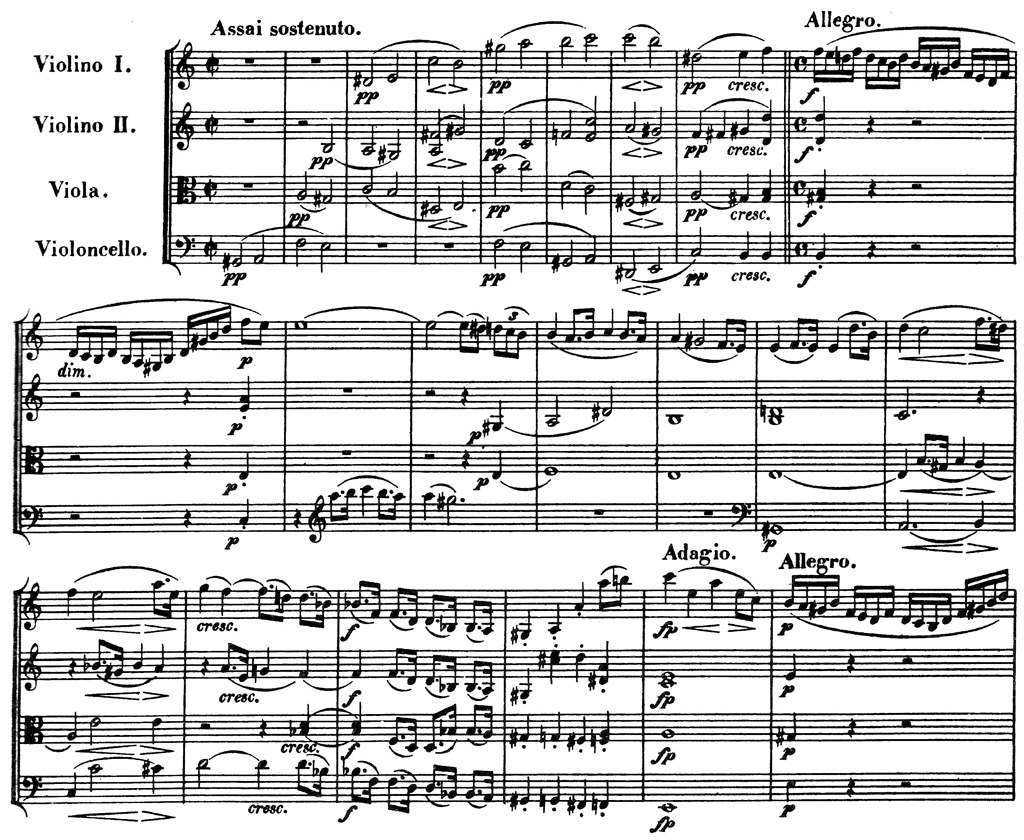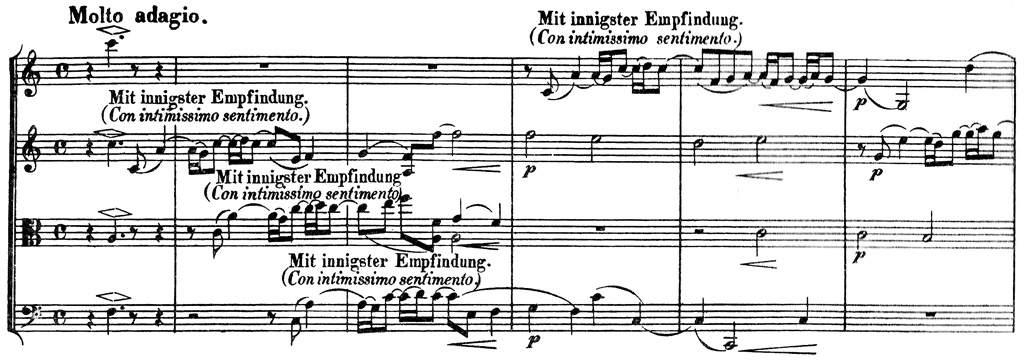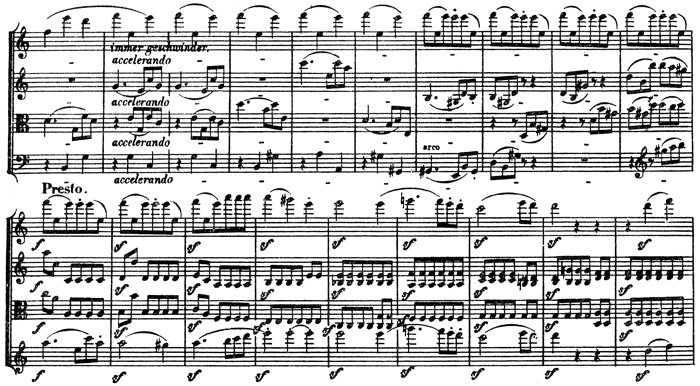Ludwig van Beethoven
String Quartet in A minor, op.132
Media Review / Comparison
2013-01-25 — Original posting (on Blogger)
2013-01-26 — Added note on the Lydian scale
2013-08-07 — New standard layout applied
2014-11-07 — Re-posting as is (WordPress)
2016-07-11 — Brushed up for better readability
Table of Contents
- Introduction / The Recordings
- The Composition
- Timing Comparison
- Comments on the Individual Recordings
- Amadeus Quartet (1962)
- Guarneri String Quartet (1969)
- Takács Quartet (2004)
- Emerson String Quartet (1997)
- Endellion String Quartet (2005)
- LaSalle Quartet (1973)
- Quartetto Italiano (1967)
- Melos Quartett Stuttgart (1985)
- Alban Berg Quartett (1984)
- Busch Quartett (1937)
- Artemis Quartet (1998)
- Leipziger Streichquartett (2001)
- Hagen Quartett (2003)
- Addendum
Introduction / The Recordings
Here’s another note on the recordings of Beethoven’s string quartets in my music collection, about the quartet in A minor, op.132 — references to the CDs are given at the bottom of the respective section, or in one of the related postings, or see the summary on the postings covering Beethoven’s String Quartets. Here’s a short list of the recordings in this comparison, in alphabetic order:
- Alban Berg Quartett (1984)
- Amadeus Quartet (1962)
- Artemis Quartet (1998)
- Busch Quartet (1937)
- Emerson String Quartet (1997)
- Endellion String Quartet (2005)
- Guarneri String Quartet (1969)
- Hagen Quartett (2003)
- LaSalle Quartet (1973)
- Leipziger Streichquartett (2001)
- Melos Quartett (1985)
- Quartetto Italiano (1967)
- Takács Quartet (2004)
The Composition
The String Quartet in A minor, op.132 by Ludwig van Beethoven (1770 – 1827) features the following movements:
1. Assai sostenuto — Allegro (alla breve, 2/2)
A difficult movement, both for the listener and for the player! For the listener, the difficulty is in the heterogeneity, the lack of form: the movement does not follow much of the classical form principles; even though there are returning melody and texture fragments (giving the impression of a recapitulation section), it is broken up by frequent tempo changes (e.g.: there are several short adagio inserts), there is no big, carrying melody, merely some melody fragments (some of which remind of the theme in the “Great Fugue” op.133).
When it was written, that movement must have sounded even much more difficult than it does to us — and some sections sound rather like a late Schubert than a composition of the classical period (in his string quartets, Schubert was definitely a composer of the romantic period).
The difficulty for the players is not so much of technical nature, but in “keeping the movement together”. With such a heterogeneous movement, there is no simple recipe for achieving that goal — except, maybe, that an excess of added agogics is likely to make it even harder for the listener to “understand” the music (example: the Guarneri Quartet). The key to this movement is probably in its dramatic, emotional content — as exposed by the Melos Quartet.
2. Allegro ma non tanto (3/4)
An interesting movement: after the hard-to-understand first one, this Allegro ma non tanto seems easier to access — it is a sort of Minuet-Scherzo, a fast waltz-like dance in the outer parts (the first part is repeated after the second one), even though the atmosphere is not entirely playful, but does have its melancholic, even grim aspects.
The (implicit) Trio section starts and ends with an enchanting hurdy gurdy imitation (second example above), which is surrounding a rather rustic country dance (reminds me of a German “Schuhplattler”), that evolves into a clumsy peasant dance towards the end, before the hurdy gurdy episode leads back to the initial (implicit) Minuet-Scherzo dance. There’s one interesting detail towards the end of the middle section:Most of the movement is in 3/4 measures — except for four alla breve (2/2) bars (just before the hurdy gurdy section returns), explicitly annotated “L’istesso tempo“. With the exception of the Hagen Quartett, everybody interprets the “same tempo” as 1/4 = 1/4 — hereby ignoring the fact that the 3/4 were counted in entire bars (not 1/4), and in the alla breve, the counting units are 1/2, again not 1/4!
If entire bars are counted in the 3/4, then the “same tempo” can only mean 3/4 = 2/2 (keeping the bars the same length) or 3/4 = 1/2. The Hagen Quartett selects the first option (which makes a nice effect here, reinforcing the rustic aspect of that section). The alternative 3/4 = 1/2 would sound rather odd, I think.
3. Heiliger Dankgesang eines Genesenen an die Gottheit, in der lydischen Tonart: Molto Adagio (4/4) — Neue Kraft fühlend: Andante (3/8) —
Molto Adagio (4/4) — Andante (3/8) — Molto Adagio, Mit innigster Empfindung (4/4)
A very long — and tricky — movement! It alternates between Molto adagio and Andante, whereby the initial Molto adagio carries the annotation “A Convalescent’s Holy Song of Thanksgiving to the Divinity, in the Lydian Mode” (translation taken from Wikipedia), while the Andante part is annotated “Feeling new force”.
It looks like there is broad consensus on what tempo to use in the Andante part: the tempo range covers 1/8 = 72 (Hagen Quartett) up to 1/8 = 87 (Emerson String Quartet), even though the latter rather feels like Allegretto, see below.
The tricky part appears to be in the Molto adagio, where about half of the ensembles take Adagio for “slow”, i.e., they play very slow (in proper annotation, this would be Molto lento — something Beethoven has never used). Indeed, the range of tempi for the Adagio part goes from 1/4 = ca. 25 (Quartetto Italiano, Guarneri String Quartet, Busch Quartett) up to around 1/4 = ca. 50 (Leipziger Streichquartett)!
My take on this is that Adagio means calm, not slow, which speaks rather for a faster (than commonly expected) tempo. I also think that the slower tempi would barely have been playable at Beethoven’s time. Last, but not least, the annotation calls it Dankgesang — Holy Song, so maybe one should take also this as an indication for a tempo that is not entirely static and with endless phrases, even though it may be impossible to make this properly singable.
Addendum: Just in case you wonder what Lydian mode / tonality is — it’s essentially a major scale with a sharp fourth stage (e.g., the C major scale, but starting and ending on F).
4. Alla marcia, assai vivace (4/4)
The “Alla marcia, assai vivace” indicates a march type movement — though rather lively, definitely not a slow march. The march consists of two parts, each of which is repeated. this is followed by a dramatic “recitativo” — logically to be played as if the first violin was a (dramatic / anxious) human voice, accompanied by rapid tremolo; the movement ends with a short cadenza by the first violin, leading into the last movement. A somewhat unusual and very short movement / intermezzo!
5. Allegro appassionato — Presto (3/4)
That’s a strange (or interesting), moody piece, with its shifted, syncopated rhythms and “crescendo waves” on every bar (in the initial segment and its recurrences), sections with intricate syncopated accents, and outbreaks with wild rhythmic “detours”, often dissonant, almost violent — though luckily with a “happy”, positive ending in a fulminant accelerando and a Presto coda.
An interesting detail: there are sections (like in the last line in the example above) where the cello and the first violin play octaves above the other two voices, and the viola takes the role of the bass!
Timing Comparison
As one of the few things that one can actually “measure” in music performances, I’m giving the approximate metronome numbers for each of the movements in the text below. As these numbers are spread over the text, I felt it would help if I collected them in a table, shown below. I have used color coding to indicate relative rates: white would be the average tempo, blue fields are slower tempi, green indicates faster-than-average performances (where the strength of the color indicates the amount of deviation from the average). Some ensembles prefer slower tempi, others are faster throughout, some are “mixed bags” (click on table for full size view):
Comments on the Individual Recordings
The order of the interpretations is not chronological (neither by recording / publishing date nor by purchase date), but follows my personal, subjective rating, my preferred recording shown last:
Amadeus Quartet (1962)
Beethoven: The String Quartets (opp. 18, 59, 74, 95, 127, 130-133, 135)
DG 463 143-2 (stereo, 7 CD); ℗ 1962 / © 1974

Recorded in 1962, with Norbert Brainin, Siegmund Nissel, Peter Schidlof, Martin Lovett — for general comments see op.18/1.
Notes on the Movements
1. Assai sostenuto — Allegro (alla breve, 2/2)
10’28”; 1/2 = 22 (Assai sostenuto ) — 1/2 = 110 (Allegro)
Broad vibrato in the sostenuto part, especially in the first violin; the articulation in the fast parts is often superficial, coarse, the first violin too dominating, the staccati rather broad.
2. Allegro ma non tanto (3/4)
7’45”; 1/4 = 180 (Allegro ma non tanto)
Too much vibrato, and very strange and strong accelerations in the initial segment (as well as later in the movement): the ensemble appears to assume crescendo = accelerando (or loud = fast) — very odd, indeed. Also, the articulation is rough & coarse, as often with these artists.
3. Molto Adagio (4/4) — Neue Kraft fühlend: Andante (3/8) — Molto Adagio (4/4) — Andante (3/8) — Molto Adagio, Mit innigster Empfindung(4/4)
16’02”; 1/4 = 39 (Molto adagio) — 1/8 = 77 (Andante) — 1/4 = 33 (Molto adagio)
Good tempo, and initially little vibrato only — unfortunately, that doesn’t last long: in the later Adagio sections, they use plenty of vibrato. The Andante is coarse, stiff, static, the vibrato is affecting the intonation, and they use a strange agogic concept, with odd accelerandi.
4. Alla marcia, assai vivace (4/4)
2’16”; 1/4 = 126 (Alla marcia, assai vivace)
A bit harsh, too much vibrato, especially in the “recitativo“.
5. Allegro appassionato — Presto (3/4)
6’36”; 1/4 = 186 (Allegro appassionato) — 1/4 = 204 (Presto)
The articulation is often careless, superficial, rough. Too much vibrato, the first violin too loud.
| Recommendation: | No |
| Rating: | 2.0 (2 / 2 / 2 / 2 / 2) |
Guarneri String Quartet (1969)
Beethoven: The Late String Quartets, opp. 127, 130-133, 135
RCA Victor / BMG Classics 60458-2-RG (stereo, 3 CD); ℗ / © 1990

Recorded in 1969, with Arnold Steinhardt, John Dalley, Michael Tree, David Soyer — for general comments see op.127.
Notes on the Movements
1. Assai sostenuto — Allegro (alla breve, 2/2)
9’36”; 1/2 = 22 (Assai sostenuto ) — 1/2 = 109 (Allegro)
Lots of vibrato, some rather strange agogics — the movement falls apart, and the sound management does not help keeping things together (sounds like four separate soloists).
2. Allegro ma non tanto (3/4)
10’36”; 1/4 = 128 (Allegro ma non tanto)
Fairly slow, feels like an Andante rather than Allegro (ma non tanto); the middle part feels (and is) slightly faster — but overall, the movement feels static, has lengths.
3. Molto Adagio (4/4) — Neue Kraft fühlend: Andante (3/8) — Molto Adagio (4/4) — Andante (3/8) — Molto Adagio, Mit innigster Empfindung(4/4)
19’24”; 1/4 = 26 (Molto adagio) — 1/8 = 82 (Andante) — 1/4 = 28 (Molto adagio)
Molto adagio: static, very slow, senza tempo, with limited vibrato in the first part — there’s more vibrato in the final Molto adagio. The players may have thought “what else can you do when playing such long, endless notes?” — I think, the proper answer would have been to play faster!
4. Alla marcia, assai vivace (4/4)
2’17”; 1/4 = 112 (Alla marcia, assai vivace)
Slow — more andante than assai vivace, plenty of vibrato. The “recitativo” doesn’t sound like one (or it’s in a strange language!).
5. Allegro appassionato — Presto (3/4)
6’48”; 1/4 = 182 (Allegro appassionato) — 1/4 = 240 (Presto)
The dynamics (crescendi) are partly suppressed / evened out; some strange agogics (sudden slow-downs), monotonous, the movement has lengths; heavy vibrato, the articulation is not always careful.
| Recommendation: | No |
| Rating: | 2.2 (2 / 2 / 3 / 2 / 2) |
Takács Quartet (2004)
Beethoven: The Late String Quartets (opp. 95, 127, 130 – 133, 135)
Decca 470 849-2 (stereo, 3 CD); ℗ / © 2004

Recorded in 2004, with Edward Dusinberre, Károly Schranz, Roger Tapping, András Fejér — for general comments see op.95.
Notes on the Movements
1. Assai sostenuto — Allegro (alla breve, 2/2)
8’55”; 1/2 = 26 (Assai sostenuto ) — 1/2 = 124 (Allegro)
Vibrato also in the sostenuto parts, very soft, often unclear articulation, sometimes sounding like “dirty” intonation, rather strong agogics, dramatic — but sometimes the flow is disrupted.
2. Allegro ma non tanto (3/4)
8’33”; 1/4 = 162 (Allegro ma non tanto)
Too much vibrato — affecting the intonation in peak notes, lacks dance character, also in the middle part. The “hurdy gurdy part” appears as a short episode, rather discreet/weak — overall, the middle part (to me) is too “soigné” / polished.
3. Molto Adagio (4/4) — Neue Kraft fühlend: Andante (3/8) — Molto Adagio (4/4) — Andante (3/8) — Molto Adagio, Mit innigster Empfindung(4/4)
17’12”; 1/4 = 30 (Molto adagio) — 1/8 = 85 (Andante) — 1/4 = 29 (Molto adagio)
They use a fair amount of vibrato in most parts — though not quite as bad as with the Melos Quartet. The Andante parts feel rather like Allegretto, i.e., their tempo is at the upper limit; the second Andante appears partly rushed, pushed.
4. Alla marcia, assai vivace (4/4)
2’04”; 1/4 = 124 (Alla marcia, assai vivace)
Too bad, this heavy vibrato that even affects the intonation. The “recitativo” part is too fast, with the articulation too soft / “washed out”.
5. Allegro appassionato — Presto (3/4)
6’09”; 1/4 = 192 (Allegro appassionato) — 1/4 = 245 (Presto)
Soft articulation, combined with a really heavy vibrato that affects the intonation, extra bulge notes, not very transparent / clear overall.
| Recommendation: | No |
| Rating: | 2.8 (3 / 3 / 3 / 2 / 3) |
Emerson String Quartet (1997)
Beethoven: The String Quartets (opp. 18, 59, 74, 95, 127, 130-133, 135)
DG 447 075-2 (stereo, 7 CD); ℗ 1996

Recorded in 1997, with Eugene Drucker, Philip Setzer, Lawrence Dutton, David Finckel — for general comments see op.18/1.
Notes on the Movements
1. Assai sostenuto — Allegro (alla breve, 2/2)
9’34”; 1/2 = 25 (Assai sostenuto ) — 1/2 = 110 (Allegro)
Rather strong vibrato, especially in the sostenuto; bulge notes, the intonation is not always quite clean.
2. Allegro ma non tanto (3/4)
9’25”; 1/4 = 150 (Allegro ma non tanto)
Very soft, somewhat “fuzzy” articulation; the “hurdy gurdy” section is very (too) discreet, though OK tempo-wise.
3. Molto Adagio (4/4) — Neue Kraft fühlend: Andante (3/8) — Molto Adagio (4/4) — Andante (3/8) — Molto Adagio, Mit innigster Empfindung(4/4)
17’50”; 1/4 = 30 (Molto adagio) — 1/8 = 87 (Andante) — 1/4 = 32 (Molto adagio)
They use a fair amount of vibrato in most parts — though not quite as bad as with the Melos Quartet. The Andante parts feel rather like Allegretto, i.e., their tempo is at the upper limit.
4. Alla marcia, assai vivace (4/4)
2’09”; 1/4 = 128 (Alla marcia, assai vivace)
Plenty of vibrato, almost throughout, especially in the first violin; partly rather soft for a march.
5. Allegro appassionato — Presto (3/4)
6’09”; 1/4 = 195 (Allegro appassionato) — 1/4 = 250 (Presto)
The heavy vibrato affects the intonation; the Presto is at the upper tempo limit — the articulation starts suffering.
| Recommendation: | No |
| Rating: | 3.0 (3 / 3 / 3 / 3 / 3) |
Endellion String Quartet (2005)
Beethoven: Complete String Quartets, Quintets & Fragments
WCJ (Warner Classics & Jazz) 2564 69471-3 (stereo, 10 CD); ℗ / © 2008

Recorded in 2004, with Andrew Watkinson, Ralph de Souza, Garfield Jackson, David Waterman — for general comments see op.131.
Notes on the Movements
1. Assai sostenuto — Allegro (alla breve, 2/2)
9’55”; 1/2 = 24 (Assai sostenuto ) — 1/2 = 116 (Allegro)
Good sostenuto; not the worst movement for this ensemble.
2. Allegro ma non tanto (3/4)
8’26”; 1/4 = 172 (Allegro ma non tanto)
The articulation is not always quite accurate — and the same I would say about the dynamics, where the contrasts between p/pp and f should be more pronounced.
3. Molto Adagio (4/4) — Neue Kraft fühlend: Andante (3/8) — Molto Adagio (4/4) — Andante (3/8) — Molto Adagio, Mit innigster Empfindung(4/4)
15’42”; 1/4 = 39 (Molto adagio) — 1/8 = 86 (Andante) — 1/4 = 32 (Molto adagio)
Naïvely, one might believe that the initial Molto adagio with its resting chords is easy — quite to the contrary: the solo quarter notes of the canon beginnings are extremely exposed and sensitive to the smallest intonation errors — and those resting chords are even more sensitive to bad intonation, as in major chords one can easily hear intermodulations. One could use vibrato to cover such errors — but that at the same time destroys the purity of the chords! I would not say that the Endellion String Quartet messes up the intonation — but one can clearly hear / feel the challenge.
On the bright side, they use a good tempo in the Molto adagio, and their vibrato is rather limited. On the other hand, the tempo in the Andante seems too fast for this ensemble — it causes occasional superficialities in fast figures, and tempo irregularities (not sure whether to call this strange agogics to lack of control / run-away tempo).
4. Alla marcia, assai vivace (4/4)
2’20”; 1/4 = 122 (Alla marcia, assai vivace)
A bit dry.
5. Allegro appassionato — Presto (3/4)
6’22”; 1/4 = 180 (Allegro appassionato) — 1/4 = 228 (Presto)
Some superficialities in the articulation, otherwise OK.
| Recommendation: | Not really — though not the worst interpretation with this ensemble. |
| Rating: | 3.0 (3 / 3 / 3 / 3 / 3) |
LaSalle Quartet (1973)
Beethoven: The Late String Quartets (opp. 127, 130, 131, 132, 133, 135)
Brilliant Classics 94064 (3 CDs); ℗ / © 1997 (Deutsche Grammophon)

Recorded in 1973, with Walter Levin, Henry W. Meyer, Peter Kamnitzer, Jack Kirstein — for general comments see op.127.
Notes on the Movements
1. Assai sostenuto — Allegro (alla breve, 2/2)
9’08”; 1/2 = 25 (Assai sostenuto ) — 1/2 = 124 (Allegro)
Using a fair amount of vibrato, not entirely convincing in the musical flow, could sometimes use more dynamic range (pp too loud).
2. Allegro ma non tanto (3/4)
8’45”; 1/4 = 165 (Allegro ma non tanto)
I like the rustic dance character in this movement, also in the middle part, and the “hurdy gurdy sections” are equally done well.
3. Molto Adagio (4/4) — Neue Kraft fühlend: Andante (3/8) — Molto Adagio (4/4) — Andante (3/8) — Molto Adagio, Mit innigster Empfindung(4/4)
14’57”; 1/4 = 39 (Molto adagio) — 1/8 = 76 (Andante) — 1/4 = 39 (Molto adagio)
A disappointment: a nervous vibrato throughout the movement, the Andante stiff, rigid, up to clumsy, lacking subtlety. An occasional portamento would be OK — but if it is done in the main theme (Andante), it should at least be done consequently, i.e., by all voices playing that theme. The entire movement appears nervous, restless — partly due to the vibrato.
4. Alla marcia, assai vivace (4/4)
2’05”; 1/4 = 127 (Alla marcia, assai vivace)
Plenty of nervous vibrato in the first violin, especially from the “recitativo” to the end.
5. Allegro appassionato — Presto (3/4)
6’28”; 1/4 = 186 (Allegro appassionato) — 1/4 = 220 (Presto)
The vibrato is at the upper limit, their playing at times a bit rough, otherwise OK.
| Recommendation: | Just for the second movement, maybe |
| Rating: | 3.0 (3 / 4 / 2 / 3 / 3) |
Quartetto Italiano (1967)
Beethoven: Complete String Quartets (opp. 18, 59, 74, 95, 127, 130-133, 135)
Decca 454 062-2 (stereo, 10 CD); ℗ 1972 / © 1996

Recorded in 1967, with Paolo Borciani, Elisa Pegreffi, Piero Farulli, Franco Rossi — for general comments see op.18/1.
Notes on the Movements
1. Assai sostenuto — Allegro (alla breve, 2/2)
10’03”; 1/2 = 22 (Assai sostenuto ) — 1/2 = 114 (Allegro)
Very good in the sostenuto; very harmonic overall, though with rather soft articulation; for me, one of the best movements so far with this ensemble.
2. Allegro ma non tanto (3/4)
8’21”; 1/4 = 172 (Allegro ma non tanto)
Strange agogics: accelerandi that (for me) don’t fit the dance character in this movement. The middle part is not very rustic.
3. Molto Adagio (4/4) — Neue Kraft fühlend: Andante (3/8) — Molto Adagio (4/4) — Andante (3/8) — Molto Adagio, Mit innigster Empfindung(4/4)
19’34”; 1/4 = 30 (Molto adagio) — 1/8 = 79 (Andante) — 1/4 = 25 (Molto adagio)
Molto adagio: with limited vibrato, but very slow (lento), static, senza tempo.
4. Alla marcia, assai vivace (4/4)
2’19”; 1/4 = 124 (Alla marcia, assai vivace)
The sound is a bit dark, “covered”, especially in the first violin.
5. Allegro appassionato — Presto (3/4)
6’53”; 1/4 = 168 (Allegro appassionato) — 1/4 = 212 (Presto)
The first violin is a bit too dominant, sounds rough / “sharp”; the Allegro appassionato feels on the slow side.
| Recommendation: | Not competitive in general |
| Rating: | 3.2 (4 / 3 / 3 / 3 / 3) |
Melos Quartett Stuttgart (1985)
Beethoven: Die späten Streichquartette, opp.127, 130-133, 135
DG 415 676-1 (stereo, 3 CD); ℗ 1986

Recorded in 1985, with Wilhelm Melcher, Gerhard Voss, Hermann Voss, Peter Buck — for general comments see op.127.
Notes on the Movements
1. Assai sostenuto — Allegro (alla breve, 2/2)
9’19”; 1/2 = 24 (Assai sostenuto ) — 1/2 = 118 (Allegro)
Dramatic, emotional, excellent concept — would be top if they didn’t use that much vibrato!
2. Allegro ma non tanto (3/4)
7’39”; 1/4 = 184 (Allegro ma non tanto)
Again here: emotional, expressive, if not dramatic in the dance parts, using the full dynamic range, etc. — but then there’s this strong vibrato, especially on peak notes… Also, I note a very slight tendency to accelerate in the central, dance-like section.
3. Molto Adagio (4/4) — Neue Kraft fühlend: Andante (3/8) — Molto Adagio (4/4) — Andante (3/8) — Molto Adagio, Mit innigster Empfindung(4/4)
18’07”; 1/4 = 28 (Molto adagio) — 1/8 = 79 (Andante) — 1/4 = 29 (Molto adagio)
Sadly, their heavy vibrato makes it hard to listen to the long, standing chords in the Molto adagio (and that tempo is too slow, static).
4. Alla marcia, assai vivace (4/4)
1’58”; 1/4 = 140 (Alla marcia, assai vivace)
Expressive, vivid, even eruptive — unfortunately with this broad, heavy / extreme vibrato, especially in the “recitativo” part.
5. Allegro appassionato — Presto (3/4)
6’30”; 1/4 = 176 (Allegro appassionato) — 1/4 = 236 (Presto)
The strength of the vibrato (especially with the first violin) puts me off, even though otherwise their playing is emotional, expressive, virtuosic, and exposing the polyphony of this movement!
| Recommendation: | Only with serious hesitations, i.e., if you don’t mind a really heavy vibrato |
| Rating: | 3.2 (4 / 4 / 2 / 3 / 3) |
Alban Berg Quartett (1984)
Beethoven: The Late String Quartets (opp. 127, 130-133, 135)
EMI CDS 7 47135 8 (stereo, 4 CD); ℗ 1982 – 1984

Recorded in 1984, with Günther Pichler, Gerhard Schulz, Thomas Kakuska, Valentin Erben — for general comments see op.127.
Notes on the Movements
1. Assai sostenuto — Allegro (alla breve, 2/2)
9’18”; 1/2 = 28 (Assai sostenuto ) — 1/2 = 120 (Allegro)
Vibrato; bulge notes — the concept is OK, though, as is the musical flow.
2. Allegro ma non tanto (3/4)
8’24”; 1/4 = 174 (Allegro ma non tanto)
Too much vibrato; somewhat stiff / rigid in articulation and rhythm.
3. Molto Adagio (4/4) — Neue Kraft fühlend: Andante (3/8) — Molto Adagio (4/4) — Andante (3/8) — Molto Adagio, Mit innigster Empfindung(4/4)
15’06”; 1/4 = 44 (Molto adagio) — 1/8 = 75 (Andante) — 1/4 = 36 (Molto adagio)
They use vibrato pretty much throughout — but at least it is calm and limited, not irritating. In fact, this is the only aspect that I criticize — otherwise, the entire movement is harmonic, uses “soft agogics”, has a good tempo (not too slow!), is never rushed, leaves time for ornaments and transitions, uses careful articulation and phrasing — no doubt: the best movement with these artists so far (had they limited their vibrato, I would probably have given them a top rating!).
4. Alla marcia, assai vivace (4/4)
2’03”; 1/4 = 138 (Alla marcia, assai vivace)
Faster than many others – a good tempo for the marcia; far too much vibrato in the “recitativo” part (in the marcia it isn’t all that bad).
5. Allegro appassionato — Presto (3/4)
6’21”; 1/4 = 186 (Allegro appassionato) — 1/4 = 225 (Presto)
Good, explicit dynamics, virtuosic, clear — sometimes a bit handsome.
| Recommendation: | No longer competitive — even though this recording has some of the best movements for this ensemble (so far, in this series). |
| Rating: | 3.4 (3 / 3 / 4 / 3 / 4) |
Busch Quartett (1937)
Beethoven: The Late Quartets opp.95, 127, 130, 131, 132, 133, 135
Pearl, Pavilion Records Ltd., GEMS 0053 (3 CDs); ℗ 1999

Recorded in 1937, with Adolf Busch, Gösta Andreasson, Karl Doktor, Hermann Busch — for general comments see op.95.
Notes on the Movements
1. Assai sostenuto — Allegro (alla breve, 2/2)
9’10”; 1/2 = 2 (Assai sostenuto ) — 1/2 = 120 (Allegro)
Good, compelling concept, overall flow — though of course with some Zeitgeist (vibrato, portamento)
2. Allegro ma non tanto (3/4)
8’04”; 1/4 = 178 (Allegro ma non tanto)
Excellent and conscious articulation! The middle part (hurdy gurdy and country dance parts) to me evokes that strange, menacing, if not ghastly atmosphere in that final country dance scene in “Romeo und Julia auf dem Dorfe” by Gottfried Keller — leading the protagonists to take their own lives (sorry for referring to Swiss classic literature here, for once). And I like Karl Doktor’s viola solo in that country dance!
3. Molto Adagio (4/4) — Neue Kraft fühlend: Andante (3/8) — Molto Adagio (4/4) — Andante (3/8) — Molto Adagio, Mit innigster Empfindung(4/4)
19’19”; 1/4 = 27 (Molto adagio) — 1/8 = 80 (Andante) — 1/4 = 26 (Molto adagio)
The first violin is too dominating (could be a limitation of the recording technique), and the vibrato is particularly problematic in long chords involving empty strings. The Molto adagio is too slow, static.
4. Alla marcia, assai vivace (4/4)
1’54”; 1/4 = 146 (Alla marcia, assai vivace)
Very good!
5. Allegro appassionato — Presto (3/4)
6’01”; 1/4 = 190 (Allegro appassionato) — 1/4 = 255 (Presto)
The first violin dominates — but this could be a limitation of the recording technique; some fairly strong rubato — otherwise virtuosic, storming into the ending with the fastest Presto in this comparison!
| Recommendation: | Very interesting historic recording! |
| Rating: | 3.8 (4 / 4 / 3 / 4 / 4) |
Artemis Quartet (1998)
Beethoven: String Quartets opp. 18/2, 59/3, 131, 132
Virgin Classics 50999 607102 0 8 (2 CD, stereo); ℗ 2000-2003 / © 2010

Recorded in 1998, with Heime Müller, Natalia Prischepenko, Volker Jacobsen, Eckart Runge — for general comments see op.18/2.
Notes on the Movements
1. Assai sostenuto — Allegro (alla breve, 2/2)
9’36”; 1/2 = 25 (Assai sostenuto ) — 1/2 = 120 (Allegro)
No vibrato in the sostenuto parts — but unfortunately rather strong vibrato otherwise. Virtuosic, with clear articulation, but the concept is not quite clear to me.
2. Allegro ma non tanto (3/4)
9’13”; 1/4 = 160 (Allegro ma non tanto)
They chose a moderate tempo (it’s Allegro ma non troppo, after all!); the interpretation is technically absolutely perfect (I love their pp!), extremely clean (I would even ignore their vibrato!) — but still, to me, this is a partial failure: the movement remains neutral, lacks all dance & rustic character, as if the artists didn’t dare playing out the folkloristic aspects of this piece, even though these are so obvious! I don’t think this movement can be adequately covered with technical perfection alone!
3. Molto Adagio (4/4) — Neue Kraft fühlend: Andante (3/8) — Molto Adagio (4/4) — Andante (3/8) — Molto Adagio, Mit innigster Empfindung(4/4)
16’28”; 1/4 = 38 (Molto adagio) — 1/8 = 77 (Andante) — 1/4 = 34 (Molto adagio)
A good tempo, a clear concept, clear, transparent and mostly careful articulation, perfect intonation — unfortunately combined with some odd ideas: already the initial Molto adagio is a strange hybrid: the quarter notes are played with vibrato, the half notes without — why? To me, this is too much “made up”: the intellectual approach does not work well in this movement!
4. Alla marcia, assai vivace (4/4)
2’03”; 1/4 = 150 (Alla marcia, assai vivace)
The marcia is fast, but OK, clean; in the “recitativo” part, I don’t see why the first violin needs to add this nervous vibrato, given all the accompanying tremolo voices!
5. Allegro appassionato — Presto (3/4)
6’44”; 1/4 = 174 (Allegro appassionato) — 1/4 = 228 (Presto)
Technically well played — sometimes a bit “made up” / “thought out” / intellectual?
| Recommendation: | One of the best interpretations in this comparison, though definitely not the best one for this ensemble, within the Beethoven series. |
| Rating: | 4.0 (4 / 4 / 4 / 4 / 4) |
Leipziger Streichquartett (2001)
Beethoven: String Quartets opp. 127 & 132
Musikproduktion Dabringhaus und Grimm, MDG 307 0854-2 (stereo); ℗ / © 2002

Recorded in 2001, with Andreas Seidel, Tilman Büning, Ivo Bauer, Matthias Moosdorf — for general comments see op.127.
Notes on the Movements
1. Assai sostenuto — Allegro (alla breve, 2/2)
9’22”; 1/2 = 27 (Assai sostenuto ) — 1/2 = 118 (Allegro)
Rather soft, lacking clarity in the articulation; some odd ritardandi — I don’t quite understand their agogic concept.
2. Allegro ma non tanto (3/4)
7’54”; 1/4 = 186 (Allegro ma non tanto)
Relatively fast, vivid, almost swinging, dance-like. The f could sometimes be a bit more pronounced. The hurdy gurdy sections are good — unfortunately, they let the tempo run away in the central country dance section: this is my main criticism on that movement.
3. Molto Adagio (4/4) — Neue Kraft fühlend: Andante (3/8) — Molto Adagio (4/4) — Andante (3/8) — Molto Adagio, Mit innigster Empfindung(4/4)
12’54”; 1/4 = 51 (Molto adagio) — 1/8 = 76 (Andante) — 1/4 = 48 (Molto adagio)
The concept for the Adagio is similar to the one of the Artemis Quartet and the Hagen Quartett (quarter notes with vibrato, half note chords without) — though the tempo is better than with the Artemis Quartet: it’s the fastest Adagio in this comparison, close to that of the Hagen Quartett. Also, it is emotional and expressive, though less light and transparent than the Hagens, the dynamic spectrum somewhat more limited, and more legato, too; the main reason not to give a top rating is their ubiquitous, rather heavy vibrato (excepting the initial, long chords). Still, a very good interpretation, even if it can’t quite match that of the Hagen Quartett.
4. Alla marcia, assai vivace (4/4)
1’57”; 1/4 = 140 (Alla marcia, assai vivace)
A good tempo, and a “living” / lively “recitativo” (though with the vibrato at the upper limit).
5. Allegro appassionato — Presto (3/4)
6’29”; 1/4 = 164 (Allegro appassionato) — 1/4 = 236 (Presto)
The vibrato is maybe a bit strong; their tempo is not too fast, so they can play out the syncopes, the rhythmic intricacies of this movement — an excellent interpretation!
| Recommendation: | One of the best interpretations in this comparison! |
| Rating: | 4.0 (3 / 4 / 4 / 5 / 4) |
Hagen Quartett (2003)
Beethoven: Streichquartette opp. 127 & 132
DG 00289 477 5705 (stereo); ℗ / © 2005

Recorded in 2003, with Lukas Hagen, Rainer Schmidt, Veronika Hagen, Clemens Hagen — for general comments see op.127.
Notes on the Movements
1. Assai sostenuto — Allegro (alla breve, 2/2)
9’28”; 1/2 = 34 (Assai sostenuto ) — 1/2 = 111 (Allegro)
In the sostenuto part, the slurs are clearly taken as phrasing slurs, not as legato, i.e., there are clear bow changes — though of course it’s still played pp, as indicated. I like these long chords without any vibrato! I see a clear concept, their playing is rhythmically clear, precise, careful, light — the movement is not played as drama, but rather in a misterioso mood. Amazing, these perfectly blending, well tunes voices!
2. Allegro ma non tanto (3/4)
7’35”; 1/4 = 210 (Allegro ma non tanto)
That’s substantially faster than all others — but still it does not appear rushed (they count entire bars, as everybody else does), and despite the tempo they accurately play out all of Beethoven’s many dynamic annotations: excellent! They make a short pause before starting the hurdy gurdy and “country dance” sections at a slower tempo (3/4 ca. 165), which makes these stand out from the rest of the movement and emphasizes the rustic (country dance) aspect of that movement: very nice (and the viola solo is the nicest one in this comparison)!
As the only ensemble, they did not just copy everybody else, but took a fresh look at the four alla breve bars towards the end of the middle section, see the general remarks with the score samples above; this alone would deserve a “bonus point” — but they don’t need that to reach a top rating, I think!
3. Molto Adagio (4/4) — Neue Kraft fühlend: Andante (3/8) — Molto Adagio (4/4) — Andante (3/8) — Molto Adagio, Mit innigster Empfindung(4/4)
15’36”; 1/4 = 47 (Molto adagio) — 1/8 = 72 (Andante) — 1/4 = 34 (Molto adagio)
Initially, the concept seems similar to the one of the Artemis Quartet: the quarter notes are played with vibrato, the half not chords without — but that’s about where the similarities end! Their tempo is faster (the second fastest in the comparison), feels more natural, better (if not perfect), one immediately feels at ease, the intonation is perfect, as is the articulation; it’s all transparent, light in the articulation, yet emotional and expressive (none of the other interpretations touched me as much as this one!), and they use the widest range of dynamics, down to the faintest, whispered pp — simply (near-)perfect!
4. Alla marcia, assai vivace (4/4)
1’52”; 1/4 = 170 (Alla marcia, assai vivace)
Clearly the fastest marcia, with the tempo at the upper limit, but very good, indeed, with light, playful, almost dancing articulation, and technically perfect! Lots of drama in the “recitativo“!
5. Allegro appassionato — Presto (3/4)
6’45”; 1/4 = 162 (Allegro appassionato) — 1/4 = 228 (Presto)
Clear, transparent, the articulation not too heavy, not overloading the movement with expression — yet emotional and technically very good: not (too) analytic / intellectual, even though initially their playing may appear cool: it takes some getting used to their approach — but to me it pays to listen into the details of their playing!
| Recommendation: | My clear preference! |
| Rating: | 5.0 (5 / 5 / 5 / 5 / 5) |
Addendum
I’m using pocket scores to follow this music while listening. The listing shows the volumes for all of Beethoven’s string quartets:
- op.18/1-6 (Kalmus pocket score No.759) —Find pocket score volume I on amazon.com—
- op.59/1-3 (Kalmus pocket score No.760) —Find pocket score volume II on amazon.com (#ad) —
- opp.74, 95, 127, 130 (Kalmus pocket score No.761) —Find pocket score volume III on amazon.com (#ad) —
- opp.131, 132, 133, 135 (Kalmus pocket score No.762) —Find pocket score volume IV on amazon.com (#ad) —









































